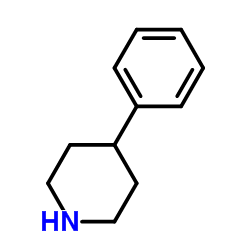4-Phenylpiperidine

4-Phenylpiperidine structure
|
Common Name | 4-Phenylpiperidine | ||
|---|---|---|---|---|
| CAS Number | 771-99-3 | Molecular Weight | 161.243 | |
| Density | 1.0±0.1 g/cm3 | Boiling Point | 259.9±29.0 °C at 760 mmHg | |
| Molecular Formula | C11H15N | Melting Point | 61-65 °C(lit.) | |
| MSDS | Chinese USA | Flash Point | 113.0±19.7 °C | |
| Symbol |

GHS07 |
Signal Word | Warning | |
|
A strategy for isotope containment during radiosynthesis--devolatilisation of bromobenzene by fluorous-tagging-Ir-catalysed borylation en route to the 4-phenylpiperidine pharmacophore.
Org. Biomol. Chem. 6 , 4093-4095, (2008) Syntheses of two 4-phenylpiperidines from bromobenzene have been developed involving anchoring to a fluorous-tag, Ir-catalysed borylation, Pd- and Co-catalysed elaboration then traceless cleavage. Although performed using 'cold' (i.e. unlabelled) bromobenzene... |
|
|
Structure-activity studies of morphine fragments. I. 4-alkyl-4-(m-hydroxy-phenyl)-piperidines.
Mol. Pharmacol. 34(3) , 363-76, (1988) The 4-(m-OH-phenyl)piperidines are a flexible fragment of the morphine/benzomorphan fused-ring opioids. Analogs in this family were synthesized with varying 4-alkyl substituents increasing in bulk from H through methyl, n-propyl, to t-butyl, each with the thr... |
|
|
Radical-mediated nitrile translocation as the key step in the stereoselective transformation of 2-(4-chloro-2-cyanobutyl)aziridines to methyl cis-(1-arylmethyl-4-phenylpiperidin-2-yl)acetates.
Org. Biomol. Chem. 10(16) , 3308-14, (2012) Non-activated 2-(4-chloro-2-cyano-2-phenylbutyl)aziridines were used as building blocks for the stereoselective synthesis of novel cis-2-cyanomethyl-4-phenylpiperidines via a microwave-assisted aziridine to piperidine ring expansion followed by a radical-indu... |
|
|
Clandestine drug synthesis.
Med. Res. Rev. 6(1) , 41-74, (1986)
|
|
|
Novel 1-phenylpiperazine and 4-phenylpiperidine derivatives as high-affinity sigma ligands.
J. Med. Chem. 34(12) , 3360-5, (1991) sigma receptors may represent an exciting new approach for the development of novel psychotherapeutic agents. Unfortunately, many of the commonly used sigma ligands lack selectivity (e.g., many bind at phencyclidine or dopamine receptors) or suffer from other... |
|
|
Influence of cocaine history on the behavioral effects of Dopamine D(3) receptor-selective compounds in monkeys.
Biol. Psychiatry 36(5) , 1104-13, (2011) Although dopamine D(3) receptors have been associated with cocaine abuse, little is known about the consequences of chronic cocaine on functional activity of D(3) receptor-preferring compounds. This study examined the behavioral effects of D(3) receptor-selec... |
|
|
Synthesis and evaluation of a set of 4-phenylpiperidines and 4-phenylpiperazines as D2 receptor ligands and the discovery of the dopaminergic stabilizer 4-[3-(methylsulfonyl)phenyl]-1-propylpiperidine (huntexil, pridopidine, ACR16).
J. Med. Chem. 53(6) , 2510-20, (2010) Modification of the partial dopamine type 2 receptor (D(2)) agonist 3-(1-benzylpiperidin-4-yl)phenol (9a) generated a series of novel functional D(2) antagonists with fast-off kinetic properties. A representative of this series, pridopidine (4-[3-(methylsulfo... |
|
|
Benz[f]isoquinoline analogues as high-affinity sigma ligands.
J. Med. Chem. 35(11) , 2025-33, (1992) This paper describes the synthesis of some conformationally restricted 4-phenylpiperidine analogues and their affinities for the guinea pig cerebellum sigma recognition site ([3H]-DTG) and the rat striatum dopamine D2 receptor ([3H]-(-)-sulpiride) in order to... |
|
|
QSAR study of 4-phenylpiperidine derivatives as mu opioid agonists by neural network method.
Eur. J. Med. Chem. 41(2) , 226-32, (2006) A nonlinear QSAR study was conducted on a series of 4-phenylpiperidine derivatives (4PPs) acting as mu opioid agonists by three-layer back-propagation neural network (NN) method. At first a variety of molecular descriptors were calculated and then selected wi... |
|
|
Na+ modulation, inverse agonism, and anorectic potency of 4-phenylpiperidine opioid antagonists.
Eur. J. Pharmacol. 494(2-3) , 121-30, (2004) Differences in the anorectic activity of morphinan (e.g., naltrexone) and 3,4-dimethyl-4-(3-hydroxyphenyl)piperidine (4PP) opioid receptor antagonists have been described. In an attempt to explain these differences, the influence of Na(+) on opioid binding af... |